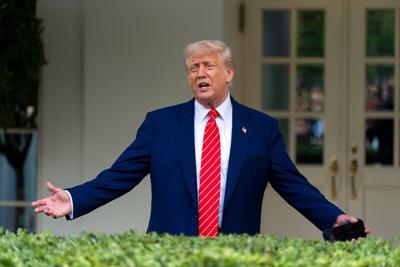Is there a part in The Art of the Deal that talks about backing down in a negotiation when your counterpart has offered no concessions?
Is there a chapter in U.S. President Donald TrumpŌĆÖs myth-making book that advises creating a situation that destroys your leverage and forces you to back off to a position that leaves you worse off than when you started your deal-making?
These are questions worth asking with the Trump administration having reached yet another bizarre inflection point in its incoherent tariff strategy, this time a temporary cessation of trade hostilities with China.
The weekend deal, such as it is, will see the United States reduce its tariff rate on Chinese imports from the ridiculous 145 per cent imposed in early April to a still-punitive 30 per cent for 90 days. China will offer a similar reduction to the tariffs it imposed on U.S. imports in response to TrumpŌĆÖs escalation.
In other words, TrumpŌĆÖs tariffs on China will go from completely insane to mildly catastrophic. ItŌĆÖs like drinking 15 bottles of wine a night and then, after a month-long bender that leaves you hospitalized, cutting back to only three bottles per night: youŌĆÖll still end up dead, but itŌĆÖll take longer.
A 30 per cent tax on Chinese imports will still be enough to bankrupt American small businesses that see their profit margins disappear due to higher input costs, and it will still lead to higher prices for U.S. consumers on electronics, clothing, toys and more.
It will also lead to higher transportation costs as businesses scramble to restart supply chains that went dormant during the month-long trade standoff and push stalled inventory across the border before the end of the 90-day pause ŌĆö or, letŌĆÖs be honest here, before Trump changes course on a whim.
ThatŌĆÖs because the adjusted terms with China, devised when it became clear that the communist nation was willing to wait America out after Trump had crashed his own economy ŌĆö governments that donŌĆÖt have to answer to voters can be quite patient, it turns out ŌĆö are just the latest representative example of a global trade strategy that has featured more tacks and reversals than a sailboat race.
Trump backed off on broad tariffs against Canada and Mexico when markets reacted poorly, and he did so again after imposing his ŌĆ£Liberation DayŌĆØ tariffs on the rest of the world last month, having gained no concrete concessions in either case. (The 90-day pause with China comes amid a different 90-day pause with the rest of the world.)
Naturally, all this has introduced the kind of uncertainty to the global business climate that usually results from nothing short of wars or pandemics, because no one knows what Trump is even trying to accomplish with his agenda. He says that he wants to force overseas manufacturing to return to America, but that would be a years-long process, and he has so far managed to keep his most punitive tariff rates in place for mere weeks, if not days, before backing off. No business would be foolish enough to alter its long-term plans given the volatility in the White House. (Pity the poor company that took Trump at his word, started building a factory in the U.S. and now has discovered that it might be able to get supplies from overseas again. Unless it canŌĆÖt. Check back in three months.)
When Trump hasnŌĆÖt been talking about returning to the golden age of manufacturing, to the good old days of the early 1900s that he seems to imagine were Peak America for some reason, heŌĆÖs said that his tariffs will put vast sums of money in federal coffers.
About this, he is somewhat correct. Despite all the backtracking, TrumpŌĆÖs global tariff rates are still around 15 per cent, higher than at any time since the 1940s. They will bring in billions of dollars of taxes on foreign imports. Only itŌĆÖs American businesses and consumers that will ultimately pay them.
All these months later, Trump still wonŌĆÖt acknowledge that part.
































To join the conversation set a first and last name in your user profile.
Sign in or register for free to join the Conversation